Just like there are cat people and dog people, so there are math people and... all the rest of the population.
You see, while we, the mortal ones, still dread the memory of a cursed math exam which ruined our final semester back in high school and shattered our dreams, self-esteem, and carefree summer vacation ahead, some find great comfort in numbers.
If you’re one of them, looking for a space to flex your math muscle, you came to the right place. Welcome to the They Did The Math subreddit where 944k took ‘do the math’ literally and came up with very interesting results. “Useless yet interesting calculations,” states the community’s description and who doesn’t like arguments proven by the power of determination and careful mathematical calculation?
Scroll down, upvote your favorite posts, and be sure to check out our previous post with more examples of people and numbers being best friends.
#1 Why Can’t People Do Math Properly? Recalculate!
"The only error here is the rounding in 4 weeks per month. There's actually around 365.24 / 12 / 7 =~ 4.348 weeks in a month.
So you'd make $5,000 * 4.348 = $21,740 per month and $21,740 * 12 = $260,880 per year.
That means it'd take you $1,000,000,000 / $260,880 =~ 3,833 years to get to a billion dollars.
Yeah, it's a bit off from what they got but it illustrates the point just as well.
All the other maths is correct."
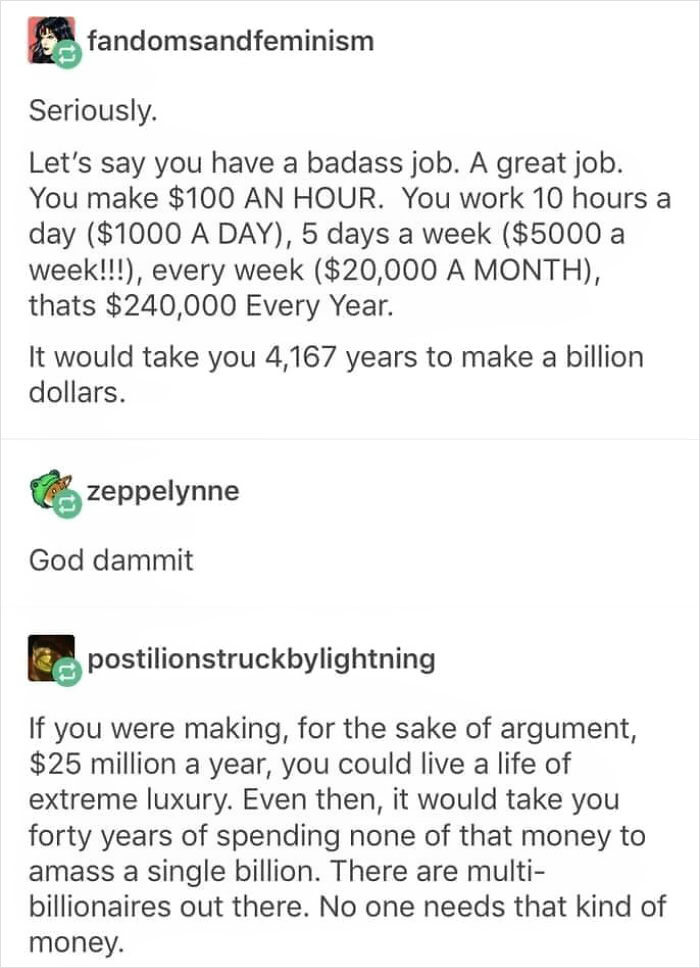
Image credits: johndecoded
#2 If You Blended All 7.88 Billion People On Earth Into A Fine Goo (Density Of A Human = 985 Kg/M3, Average Human Body Mass = 62 Kg), You Would End Up With A Sphere Of Human Goo Just Under 1 Km Wide. I Made A Visualization Of How That Would Look Like In The Middle Of Central Park In NYC

Image credits: kiwi2703
#3 Is This Really The Price Difference In Wood Between January 2020 And June 2021?
"For what it's worth, I live in the pacific northwest - timber country - and the price of wood has gone up over 100%. Elsewhere I know it's more. I have been harvesting fallen trees in the woods for projects lately. The complication with this question is that the prices have inflated different amounts in different places . So this could be correct where the photo was taken."

Image credits: WombatKiddo
#4 Can Someone Confirm Its True?
"Oxfam international said that... I don't know the exact figures but simple logic dictates that it certainly can easily be true. Think about it, most people in the world are poor, which means they have little to no net worth.
If Bezos has a net worth of 200 billion and each of these 4 billion people have 50 dollars in net worth, then you're already there. 50 dollars in net worth is not an outrageous number given that many Americans have negative net worth and little to no savings to speak of.
I don't know how much the top 8 are worth, but let's say it's 1 trillion. That means that the 4 billion are worth 250 dollars. Yeah that's plausible.
By the way even if you make 100,000 a year in the US you can have a net worth of 0 or negative net worth depending on what your savings/investments and liabilities are, which is often the case."

Image credits: TurtleRedditer
#5 How Much Memory Could Be Stored Today In The Same Volume As The Image On The Left?
"A micro SD card has a volume of 165 mm3. I estimate that box to be 8'x3'x20'.. This comes out to around 82 million SD cards, assuming a 100% packing efficiency. At 1TB per card that would come out to 82 Exobytes. .
It's hard to find a reliable estimate of the total data on the internet, but this website says 44 zettabytes, which means our box contains about 0.2% of the internet. Storing the whole internet on 1TB SD cards would take around 7300 m3, equivalent to a cube about 20m per side or 3 Olympic swimming pools"

Image credits: Tinnber
#6 I Stumbled On This Post And I’m Wondering If This Is True! Any Ideas ?
"According to the source it says it would take $20B to eliminate homelessness
The most expensive US aircraft carrier is $12.8B. So it's about 7.2B short. However, this is only the cost to build it, and excluded operational costs."

Image credits: hello_friend_mkv
#7 In Soviet Russia, Coffee Is Served At A Ridiculous Pace
"For anyone wanting context, Stakhanov was a common caricature for a while in soviet culture (based on a real person), about people who go way above and beyond in their job. Like a chuck norris, but for manual labor.
It started out serious (the real person apparently hauled 100 tons of coal in 6 hours), and he was promoted as a person to be emulated. But the tales got more and more outlandish as time went on, as people got disillusioned with the whole idea"
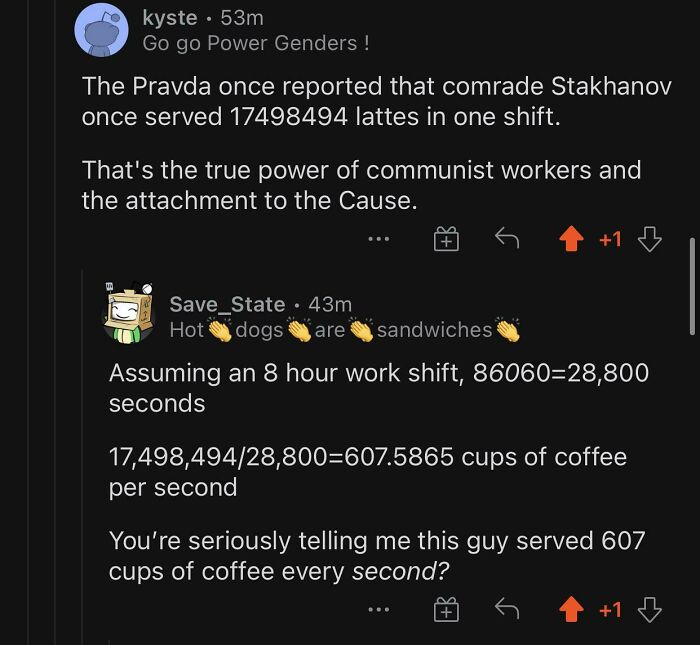
Image credits: justthatoboist
#8 Scott Manley Did The Math
"Couple issues with this post.... 1) it’s not downloadable on Steam 2) Ark: Survival Evolved is much larger with dlc involved."

Image credits: ControlledPairs
#9 Shows Us That Germany Has Bad Average Connection Speeds

Image credits: DStellati
#10 What Would The Price Difference Equate To? How Would Preparation Time And Labor Influence The Cost?
"I think we have to work this out at UK prices, because, as people have pointed out, that's a £3 tesco meal deal on the left, with a starbucks drink and a pastry. Also, we need to compare like with like, and US and UK food prices are vastly different.
As the meal deal items are from tesco, we can get the nutritional info from the website, which is important for working out the price.
The Salt and Vinegar McCoys are 251KCal, coke is 210KCal, and the sandwich looks closest to their chicken bacon and stuffing sandwiches, which is 483KCal. That's 944 KCal, so the other two items should add up to around 656KCal.
As three items are from tesco, I'm going to guess the other two are from the same store and that's a butter croissant from starbucks, at 259KCal costing £1.19 if you eat out, which I'm guessing is the situation as they've been taken away for this photo.
That means the drink is something from starbucks with 397KCal. A 500ml coke bottle is 23.5cm high, so that looks like a 18cm tall starbucks cup, maybe 16cm without the lid. A venti cup is a little over 15cm tall, which means that's a venti.
There actually is a venti drink from Starbucks with a calorie count of 397, which is a hot chocolate with whole milk, and as that's £2.65 to go, that brings the left hand total to £6.84.
That's the easy part.
Now the right hand side. Reverse image search on the cropped right hand side didn't show anything up, so doing it the hard way, we have avocado on ryvita, mixed berries, yoghurt with mixed berries, Looks like spinach on two of the plates, kale on two, yoghurt, broccoli, cauliflower, tomato, and then it is a bit more guess-y. Top right plate has some sort of grain, maybe rice, maybe bulgar wheat or somthing. There's also something spreadable, I'm guessing houmous. I'd guess that's bulgar wheat with bell peppers, houmous with a little paprika on top, and kale.
The plate of mixed berries in the middle towards the top just looks like strawberries and blueberries.
Left hand side middle looks like yoghurt with chia seeds sprinkled on, wilted spinach, and something red which looks tomato based, so maybe a salsa? I could be way off and it could be a mashed root veg like carrot or sweet potato also, but I think I see a little liquid from it at the lower end where it meets the spinach, so I'm going with a mild salsa.
On the middle right, there's broccoli and cauliflower, kale and something red, which I think is tomato, but may possibly be bell pepper? The other item is a little harder, but I think that's a baked potato with tuna filling.
Bottom left plate is wilted spinach again, tomato, and some sort of mushroom dish. Looks like there's kale, tomato, and something else in there. Maybe cauliflower, but very possibly a bunch of ingredients you can't tell at that resolution and just from a picture.
Bottom right is just yoghurt with more strawberries and blueberries.
Now for pricing. I'll get the prices off tesco, but lots of this stuff is seasonal, so it'll vary through the year. Note that UK food prices are lower, 'cause last time I did this, no-one believed we pay so little for food. You can check the prices at tesco.com if you use a vpn or something to pretend you're in the UK.
Ryvita - get the off brand ones for 69p. About 28 per pack, so 5p for the ones shown. I'll do all the pricing like that as you could divide the food amongst multiple meals or multiple people.
Avocado, 75p. I'm going to say that's a whole avocado in the image.
Bulgar wheat, 500g for £1.15, so let's say 75g, costing about 17p.
Bell pepper, 86p for 3, so probably 28p for one will get you enough bell pepper for all the stuff in the picture.
Houmous, £1.10. You can make it yourself for less, but that's a bit OTT for this calculation.
Regular kale is out of stock when I searched, which is fine, as whenever you do this you'll find some stuff is more expensive, so it'll even out. That means buying the expensive kale, at 1.5 for 200g, which will do all the kale in the picture.
Let's make sure to include the paprika, which is 90p for 52g which can mostly sit in your cupboard, so let's add 2p in paprika.
Strawberries - £1.39 for 227g, enough for the whole image.
Blueberries - 89p for 125g, again enough for every dish.
Mild salsa - 80p
spinach - 900g for £1.50. Given how much this stuff shrinks as you cook it, even if you could split it over more than one day, I'll play it safe and just say that's for this set of meals.
Chia seeds are £1 for 150g, so that's maybe a 5p sprinkle at most.
Yoghurt - 75p for 500g, which also means we now have everything for the bottom right dish.
One big spud - 25p
tuna - £1.20 frozen bag of cauliflower and broccoli mix is 89p for 900g, so that's 25p in broccoli/cauliflower at most.
We already have the kale and pepper
One tomato - 15p
two mushrooms - 12p
We probably already have the other ingredients, but let's add in a little more in case there's something significant missed for that recipe. Based on the existing prices, I'll add in another 10p for a possible mystery ingredient.
That gives us a total of £11.32 for the stuff on the right, vs £6.84 for the stuff on the left.
Labour time will influence the cost, but all the actual meals on the right are super quick to prepare. The worst might be the potato, but even then it's about a minute to prepare it, then you just leave it in the oven and come back. All the meals have suprisingly low prep time."
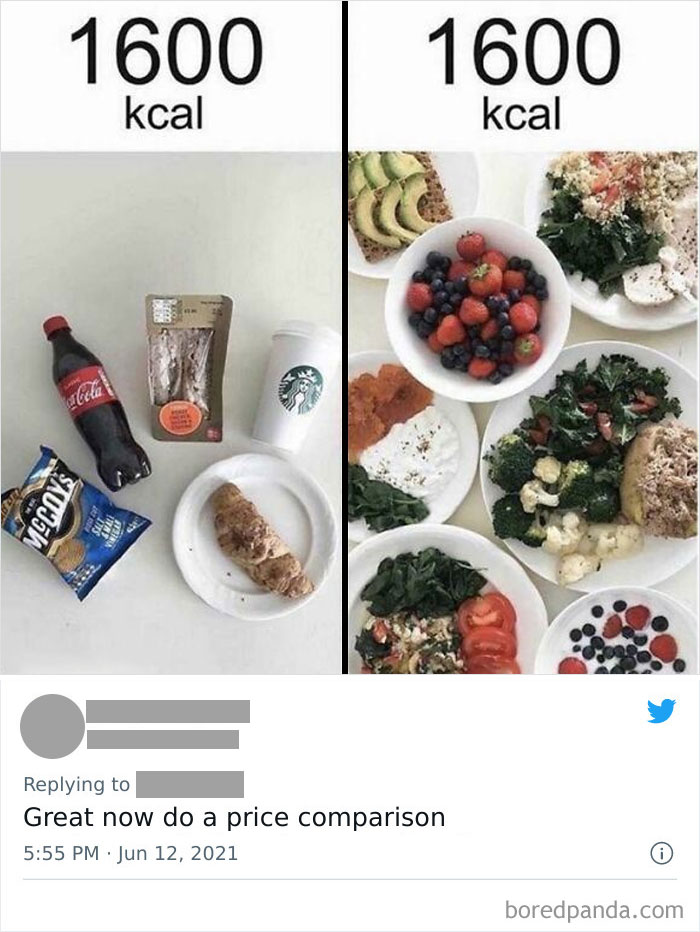
Image credits: Skibum_26
#11 Is This True?
"The video I just saw showed that they spent about 5 minutes naming the victims of 9/11, of which there were 2997 victims. Johns Hopkins has the USA at 463,437. All you need to do is set up a ratio.
5 minutes / 2997 deaths = x minutes / 463437 deaths
463437 * 5 / 2997 = x
x = 773.1681681681681681681681681681...
Which works out to 12 hours 53 minutes 10.09 seconds"

Image credits: BuhtanDingDing
#12 Could Jeff Bezos Really Give All Amazon Employees $105k And Still Be As Rich As He Was Before The Pandemic?
"It’s complicated. Maybe calculated as his net-worth that’s probably true, but you need to understand that he hasn’t that money just lying around.. most of his wealth is bound as amazon stock. He can’t just take money and give it someone else. And if he‘d give away amazon stock, it would probably crash the stock market and would be guilty for market manipulation, regulations are pretty strict on that.
Yes, he should definitely do much more for amazon employees, but assuming he can just hand out sh*tloads if money doesn’t reflect reality."

Image credits: thismustbethursday
#13 How True Is This???
"Jeff Bezos net worth: $181,200,000,000
Baltimore average net worth: $555,423
Baltimore median net worth: $255,000
Baltimore population: 593,490
Total net worth (without Bezos): $329,637,996,270
Total net worth (with Bezos): $510,837,996,270
Average net worth, with Jeff Bezos: $860,735.
(I assume the median would remain at $255,000)"
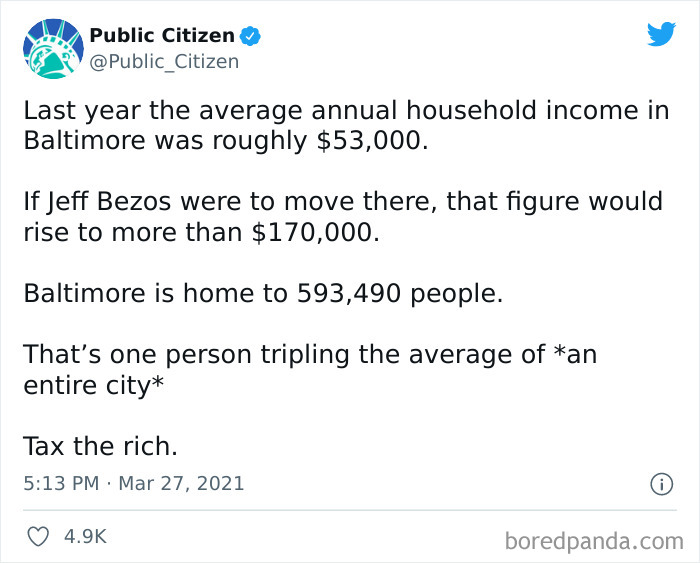
Image credits: marineoceanmist
#14 How Long Till The Average Person Farts 500k Times
"The average person farts between 5-15 times a day, using the median (10) it would take 50000 days to fart 500k times. This is 136.9863 years."

Image credits: Bobbybytes
#15 How Long Could An Average Car Stay On Before Running Out Of Gas?
"The average car is a Toyota Corolla which has a gas tank big enough to hold 13.2 gallons of gas. An average car uses about 1/5 of a gallon of gas an hour if you let it idle. 13.2÷.2 is 66. So about 66 hours in a full tank. I did a whole 5 minutes of research on this and I don't know if I used the right equation so I may be wrong"
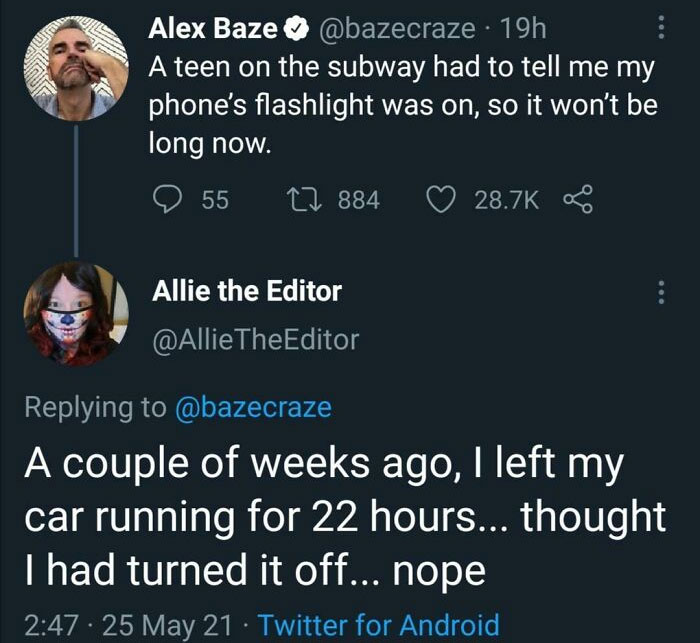
Image credits: ZauChoco
#16 Does Zuckerberg Hold 2% Of All Millennial Wealth?
"Millenials own 5000B wealth, per this:
https://bit.ly/3E1xbvj
Zuckerberg owns 111B of it, per this:
https://bit.ly/3k06qPU"
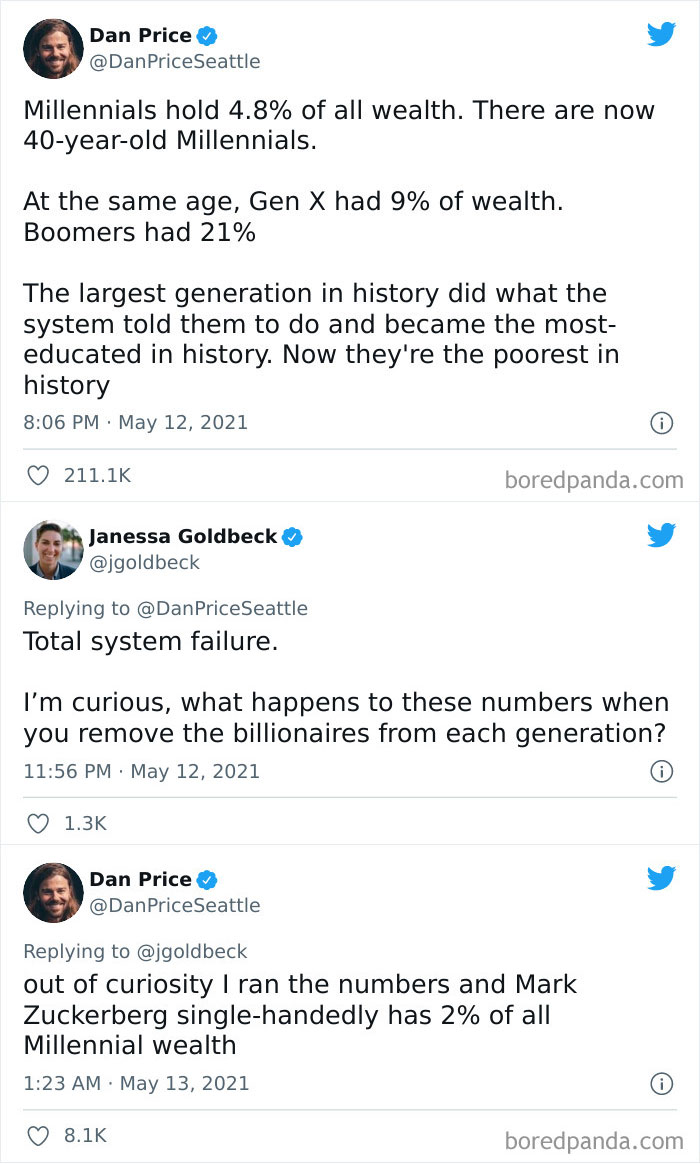
Image credits: Mr_Pombastic
#17 Is This Why It's So Hard To Buy A House These Days?
"Now, there are issues with this, because we aren't weighing population growth and decline in these cities (rust belt population, demographic collapse of certain cities such as Detroit, etc.,). I think they just took "average price in X city." Back then there wasn't the insane income inequality from city-to-city either, so that factors. (e.g., median wage in a city that would go on to form the Rust Belt back then was closer to that of the coastal cities. Now you can famously buy houses in ghettos where there are no jobs for very little money- but you have no municipal services, among other issues.)
I genuinely think they just "averaged" these cities out by 'large municipal area.' I can't factor for wage growth in areas like Silicon Valley. We've seen extreme bifurcation in value and wages in these localities since 1971.
So, I instead took just my nearest city I lived in, Philadelphia. It's a sort of "normal" city that isn't an outlier (it's not exactly Detroit, nor San Francisco, but 'somewhere in-between.') So I'll use it as a yardstick, because I'm not spending more than like, 5 minutes on this thing, and hell, someone's gotta actually take a swing at this.
In 1971 a home in Philadelphia was 14,800, or in today's dollars, just a hair under $100,000.. For today, however, in that same municipality, it is $280,000., with the data ending in June and showing zero signs of slowing if you look at the chart's rising tail.
For everyone saying "but it doesn't have modern amenities-" I don't think anyone buying a "starter home" cares if it was built in the 1800s, 1900s, 1950s, 1970s, or today. Most want a place to build equity where they can stop burning their cash on rent and start putting it toward saving, maybe move up to a better home later once they have the equity.
Most places are at least wired for some kind of broadband. Most places have electrical outlets that meet code.
Past that, you can run either a window unit or space heater if you really have to, with the other differences being so small as to not matter, (at least when it comes to starter homes. It's not like it's a smart home that's hyper-modern.)
Starter homes of a modest size aren't really built anymore- and there's a reason for that. But for people 'starting out' in homeowning, it looks like the last few years and some change just made that a lot harder."
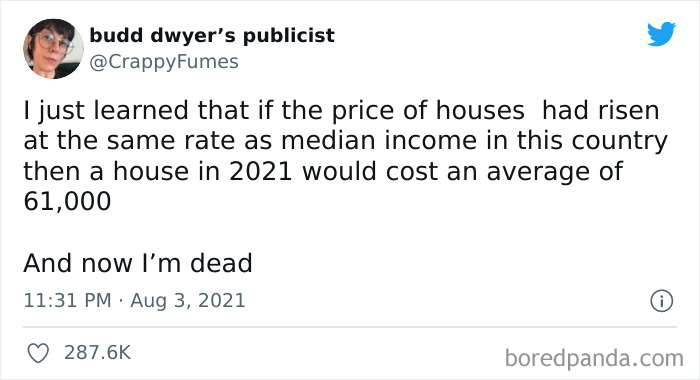
Image credits: aaronc0401
#18 Making Water At Home Is Something You Might Not Want To Be Home For. Or Have A Home After
"a. Isn’t this basically rocket fuel and b. I’m pretty sure they do this in the Martian if you’ve seen the movie. otherwise cool calculations"
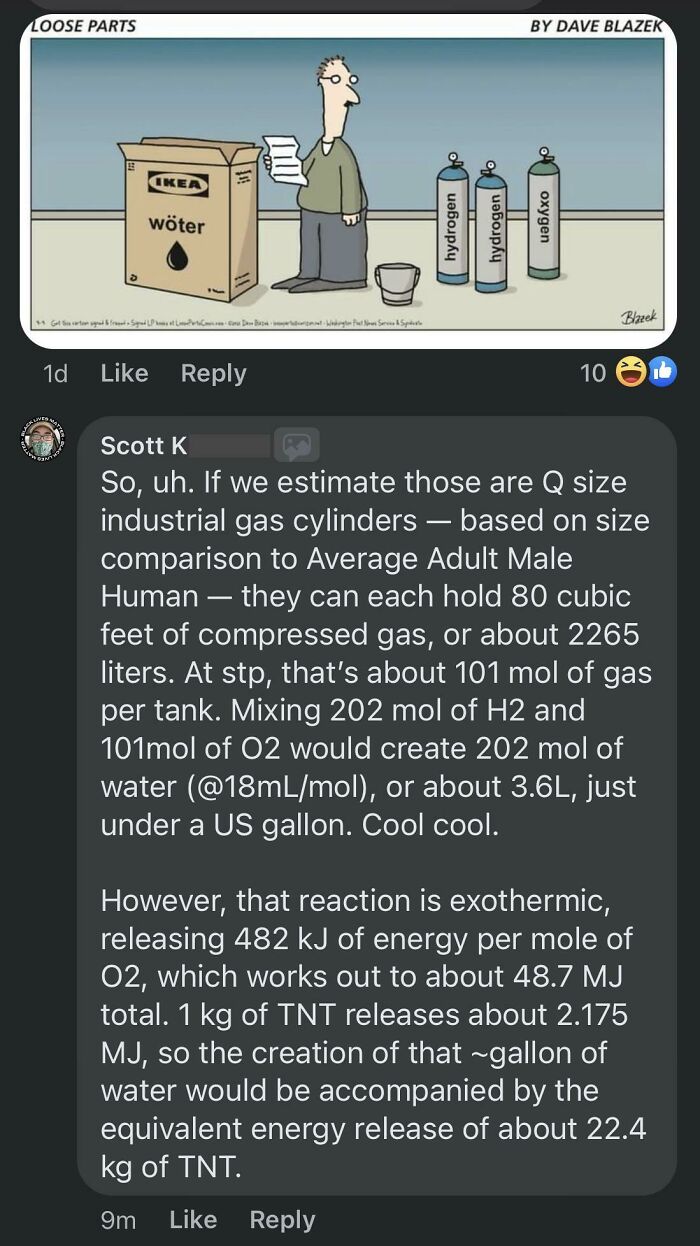
Image credits: Skreidle
#19 Math Lead Them To This Conclusion
"Lead can also be created directly in supernova explosions. It doesn't have to originate from nuclear decay."

Image credits: Filthydogg
#20 A Mate Of Mine Did Some Snail Travelling Maths

Image credits: Cyrinic
#21 Calculating Rent In 1940
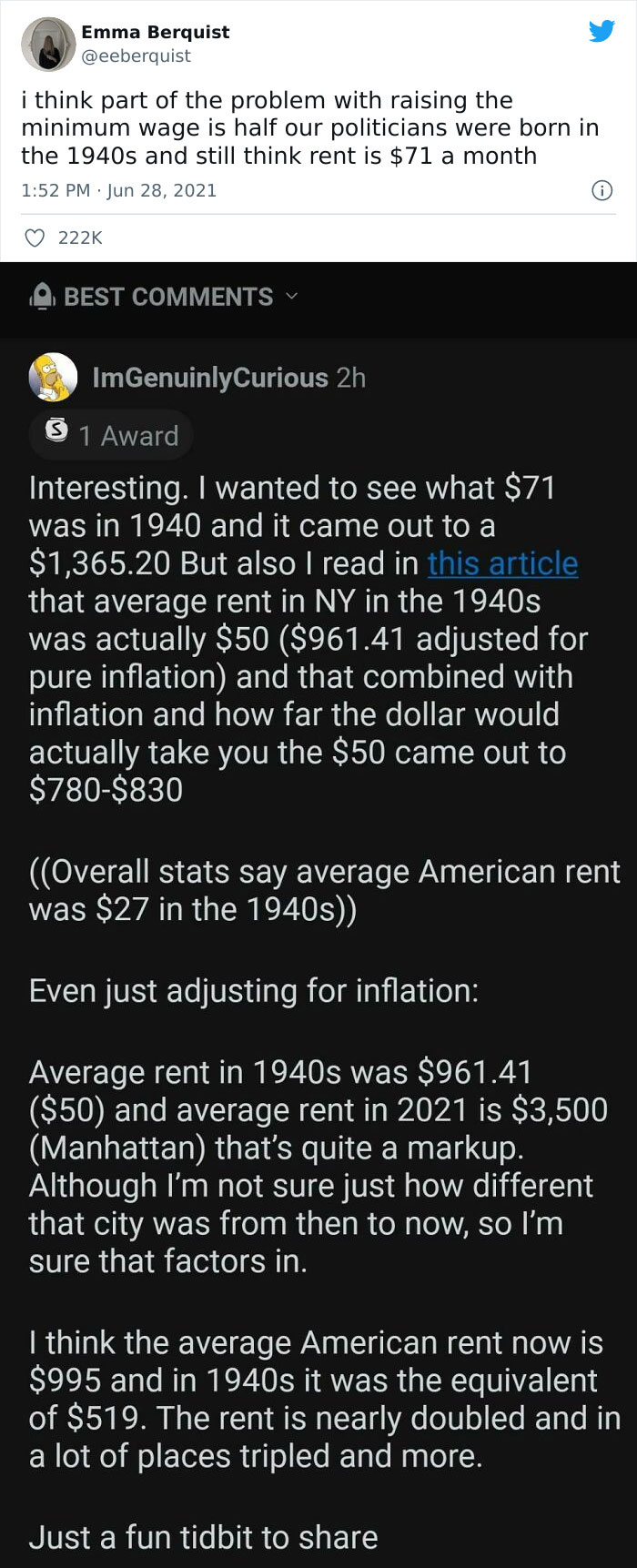
Image credits: TheLoneCalzone
#22 What Speed Could A Sleigh Reach Going Down This Ramp? Would It Go Airborne?
"There appears to be 37 steps in the image, and if we assume that the ramp goes the whole way up, we can guess the height of the ramp to be:
37 * avg step height = 37 * 7.5 inches = 23 ft 1.5 inches = 7.05 meters
The change in slope happens 20 steps up, or about 12.5 ft = 3.81 meters. Let's assume this changes from 30 degrees to 45 degrees.
There's a short answer where the speed is just energy conservation:
v = sqrt(2 * g*h) = sqrt(2 * 9.81*7.05) = 11.76 m/s = 42.3 km/h = 26.5 mph
At the slope change, the speed is 8.00 m/s or 28.8 km/h or 18.0 mph, which is definitely fast enough to leave the ramp.
We could include air resistance and friction, but at these speeds, they don't change much:
Here's the force balance:
F_horizontal = m*g * sin(angle) - m*g * cos(angle) * mu_rolling - 0.5 * air_dens * v^2 * A * C_D
According to this paper, wheelchairs with air-filled wheels have a rolling resistance roughly on the order of 1% of the load against the surface. This means we're looking at about 1% loss from friction, which is negligible.
This 70's NASA report, we can place a drag coefficient of 1.4 to the person and a frontal area 0.465 m^2 for air resistance. If we assume a total man + wheelchair mass of about 100 kg and an air density of about 1.1 kg/m^3 (I'm guessing this is some kind of foresty area with about 1000 m above sea level), we can estimate air resistance at any speed.
If we were to use our fastest 11.76 m/s theoretical speed, the air drag works out to about 50 Newtons of force. Compare that to almost 700 N of force from just gravity along the ramp at 45 degrees, it's pretty small. At the midway point, drag would only be about 23 Newtons compared to about 500 Newtons from gravity at 30 degree slope, staying under 5% over the first half and under about 7% for the second half.
This means we have maybe around a 5% drop in force the whole way on average or so, which is equivalent to 5% drop in energy. However, since kinetic energy is v^2, this corresponds to sqrt(100% - 5%) = 97.5% or only a 2.5% drop. So by the end, we'd probably see speeds around 25.8 mph instead of 26.5 mph.
Hope this was interesting"

Image credits: chique_pea
#23 Aside From The Meme, Is This True?
"The conversion formulas are:
SPL = 20 * log10( p / p_0 )
p = p_0 * 10 ^ ( SPL / 20 )
With p_0 = 2e-5 Pa and 194 dB you get 100 kPa or 1 atm. After that point a sound isn’t really a sound but more of a shock wave, and it’s not clear how meaningful dB measurements are.
At 1100 dB you get a pressure of 2e50 Pa. Pressure isn’t really the right way to measure a black hole because size is also very important. But for reference, a Neutron Star, where atomic structure has collapsed, can have a pressure on the order of 1034 Pa. So 1050 Pa sounds like enough to me."

Image credits: auniquexd
#24 How Many Bees ?
"Some additional math:
- 10k bees weigh about 3 pounds, so 6.3M bees is about 1900 lbs. No problem for the car.
- 1/2 cup of bees (0.00418 cu ft) = 300 bees. Using that with a 141.3 cu ft interior results in 10.1 million bees.
- 30k-60k bees need 2 deep boxes for a hive (3.33 cu/ft). So if you wanted the bees to build a hive in the Lexus, there would only be room for 1.2-2.4 million bees.
Any way you do the math, it's the same order of magnitude."

Image credits: blesser-of-rains
#25 How Much Money Would It Be If The U.s Government Did This?
"First source I found shows FY2020 military budget is $714B, so cutting 25% would be $178.5B. I think that's a conservative number, considering that they may have gone over budget and it'll likely increase going forward.
A very simple look at wealth tax would be looking at total net worth of millionaires or billionaires in the US. Not able to find a distinct number for millionaires, but I see that the 660 billionaires in the US have a total wealth of $4.1T. 1% of that is $41B."

Image credits: Kronos666666
#26 Big Ooof If True. I Checked The Link And The Numbers Did Make Sense. Can Someone Double Check With Me?
"So the US spent $718.69 billion on military stuff last year. So 3% of that is $21.560 Billion. Using the stats from this website:
https://bit.ly/3tC6bOb
You’d have to be able to feed each of the ~820 million critically hungry people on $26.29 each- for a whole year. maybe feasible in some countries, since the US dollar can be pretty strong, but definitely not in most.
Granted, the sign could be suggesting an investment in infrastructure to make food cheaper for everyone. But on the face of things, you could probably end world hunger for maybe six meals"
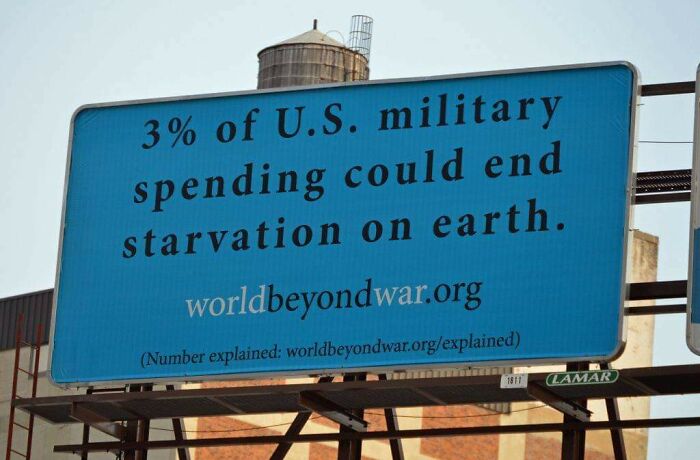
Image credits: DontTrustJack
#27 Pretty Solid Plan!!

Image credits: MV_119
#28 Found This “Girls In A Group Photo” Meme. How Many Combinations Are There?
"The following ‘calculation’ is done by assuming that the position the girls are trying to form a \\ \ | /// formation.
If 3 girls have the same side, that means one side (e.g. \\ \) will be completely taken by those three girls. If we consider \\ \ as 1 2 3, the number of combination possible is 6.
1 2 3, 1 3 2, 2 1 3....
Put that aside for now and let’s look at the remaining 4 position. All that is left are the | /// position open.
As 2 girls do not want to be in the middle, the only positions they can take are / / /. Assuming the two girls are named A and B. Assuming the last 2 girls who does not have any preference are named Y and Z.
That means the possible combinations are....
A B _ A _ B _ A B
Edit (thanks to luigi_itsa for pointing the missing combination below and made corrections for the calculation that follows):
BA_ B_A _BA
Fill Y and Z into each _ and you’ll get 12 possible combination for | ///.
Taking it all together, assuming each \\ \ combination have 6 different | /// (I.e. 12 combinations as well)...
We get a total of 72 different possible combinations that are happy with the photo.
Bonus: if you want to include the possibility that the 3 girls that have the same side prefer the other side, then just multiply that combination by 2 which gives you 144 possible combination."

Image credits: purplexy
#29 I Saw This On R/Memes And Was Wondering How Far This Will Take Us From The Sun By The Time It Swallows Earth
"There's a paper published that calculates what fate the Earth suffers due to the sun swelling into a red giant. I'll see if I can find it.
Here it is:. https://bit.ly/3E2rpJP
Anything inside 1.15au currently is doomed.
To elaborate: the sun will likely puff up to red giant with a diameter encompassing Mars. Which suggests that Earth will definitely be engulfed. That simple model however neglects that the sun will have lost a significant amount of mass by then which would tend to cause the orbits of the planets to expand. The paper calculates that even given the mass loss the Earth is still doomed."
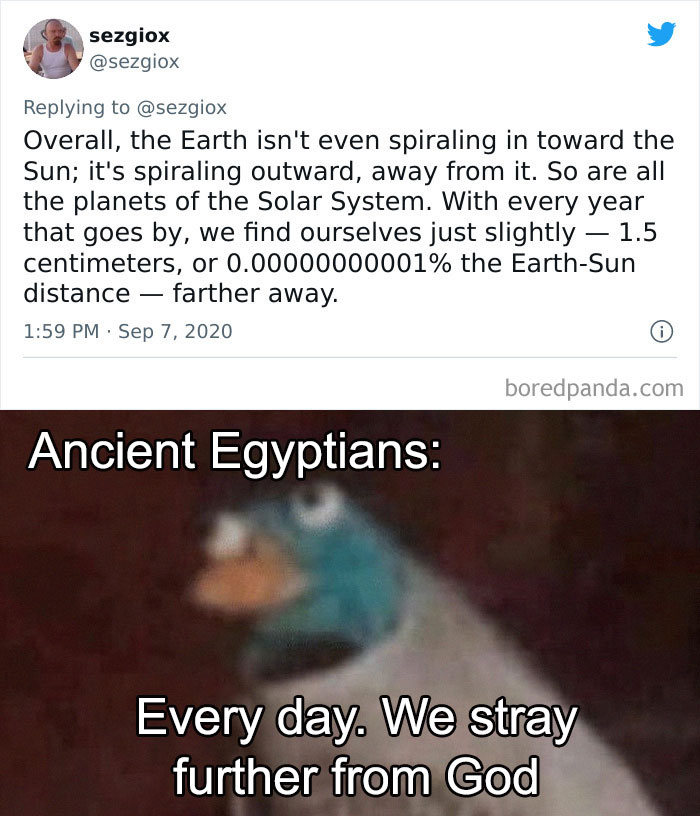
Image credits: HelpImDyingByDesign
#30 So About How Many Extra Nuggets Would That Be?
"Let's assume that this is part time worker. We can't say for certain how many hours they would get in a given week, so we will assume that they work 20 hours per week.
It was stated that they worked at McDonald's for 2.5 years. With 52 weeks per year, this would give us a total of 130 weeks (52 x 2.5 = 130).
At 20 hours per week, for 130 weeks, we have a total of 2,600 hours worked (20 x 130 = 2,600).
The remaining variable is how many orders of 10 piece nuggets occur each hour. Each order represents 1 free nugget. There are many factors which determine how many orders there are per hour:
-The number of 10 piece nuggets ordered would be higher during peak dining hours, and lower during off peak hours.
-Nuggets aren't served during breakfast hours.
-Location would have a major impact on this number. We would expect a location in a densely populated area to have lots of customers (and therefore more orders of 10 pice nuggets each hour). We could assume that a store in a more remote location would experience a smaller number of customers.
For simplicity, let's assume that there are 10 orders of 10 piece nuggets per hour.
With the assumptions above, we have the employee working for 2,600 hours, giving away 10 free nuggets in each of those hours.
2,600 hours x 10 free nuggets per hour = 26,000 free nuggets"

Image credits: FravenD
#31 Is This True? And If So, How Did It Get This Way?
"Alright.
Currently it's $9,687 for public in-state college.
Nationally minimum wage is $7.25. I'll be ignoring that each state and certain municipalities have different minimum wages, because Bernie is a Federal senator, so he is arguing for the Federal Minimum Wage to be raised (or cost of college to be lower. Bernie's argued for both, but the point stands that he's in a Federal position, so I'm taking aggregates for all in-state tuitions and federal minimum wages.).
A 4-year program ($9,687 x 4 = 38,748) costs $38,748 USD.
Bernie says 4459 (hours) x 7.25 (wage) = $32,327.75 USD.
So, no 4,459 hours does not pay for even in-state tuition for four years. This data is actually too optimistic.
Bernie is off by 885 hours.
Now let's do the 1960s. In 1968, the cost was $329 per year.
$1.60 was the minimum wage for that year, but this was admittedly minimum wage at its peak value in American history.
306 x 1.60 = $489.60. This would have paid for about 1.5 years of college, not four. During the '70s and '80s, the purchasing power fell a bit during stagflation/inflation and fees/admin bloat rising. Let's say that now it would pay for about 1.33 years of college for the simple sake of rounding and me wanting to wrap up work on this unpaid little venture.
So, let's say that a boomer would have had to work closer to 918 hours, not 306 hours on minimum wage..
That is three times the number of hours Bernie's claiming a boomer needed to work to afford college for four years, but still FAR off from what today's people have to work to afford tuition, too. (Remember, Bernie actually had the Millennials' (Sigh...Zoomers') figures off, and was too optimistic. They don't have to work 4459 hours, they have to work more. I leave it to someone else to crunch the numbers to figure out how many more, I'm going back to writing my book.)
So, Bernie is broadly correct in that it takes a vastly greater number of hours on the same minimum wage that young people are often paid at, in order to pay off their college degrees. Bernie is also wrong in that it was not nearly so easy as Bernie says it was for Boomers. (I'm not taking any sides here, I'm just trying to math.)
One interesting insight from this, pointed out by /u/ravenhr, is that the amount that Bernie was off by for Millennials (Sigh...Zoomers)and I initially considered as practically a "rounding error" is by ~885 hours. Or almost what a Boomer would have had to have worked to afford all four years of college.
So, "Is Bernie's math right, according to this very superficial analysis?" No. Not even close.
But "Is Bernie's point valid?" Yeah, pretty much.
Caveats and disclaimers: This leaves out a lot. This is a very surface-level analysis.
Some examples: academic and athletic scholarships.
How far a degree gets you (whereas now people need a Masters or PhD to do what a Bachelor's once sufficed to accomplish in terms of conferring positions and a career), out of state tuition, private schools, what 'average minimum wage' is , (etc.,) as well as the fact that the average it takes someone to earn a 4 year degree is 5.1 years. (This isn't surprising because unless you are overloading your coursework, 4 is the minimum, and almost no one wants to overload just to get one degree. Most high achievers just elect to do a double major and stay in college for all four years.) Since Bernie specified "to pay for 4 years" we're going with "4 years" as our measurement. Just be aware that the extra year that it takes most people to get their degrees means that the situation's even worse in terms of debt, if the math has worsened (as it seems to have. This is how it scales.)
I've also seen some vagaries in the cost of public college- I'm not sure if some people are leaving certain fees off, or so on. I know we've left a lot of fees off (e.g., room/board, among others). This is just tuition (since that's the most consistent figure you'll get- room and board can be skipped if you elect to rent, for example, and then you need to take into account average rentals for people aged 18-21 in each college town. I don't have access to this kind of data, so I just went with "tuition alone.") I also accounted Boomers' college fees for tuition alone. I'm aware rent is considerably more expensive now, as well, but factoring for these was too difficult without reliable data, and grew the scope of the project beyond what I care about (without getting paid.)
This is a VERY surface-level examination of the issue.. I also can't say how he came up with his figures. It's possible he did do a lot of research and came up with it off national average minimum wages and then tallied those against their in-state tuitions for the Millennials (Sigh...Zoomers) figure. I'm pretty sure that the Boomer figure is off, though, given that I used 1968 (max purchasing power for minimum wage).
And I think that this is not counting Social Security, though you might be able to apply for Financial Aid assistance."
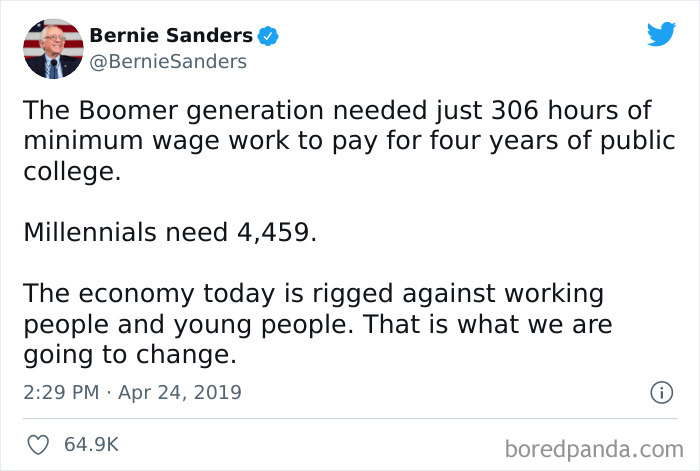
Image credits: DLLuzifer
#32 Is This Correct? And How Much Power Could That Generate?
"That 5.5% figure is very clearly bullshit.
The mainland US covers 3,119,885 mi2. 5.5% of that are
3,119,885 mi2 * 0.055 =~ 171,593 mi2.
There are a bit less than 300 million motor vehicles in the US, but let's use that number to highball (note: that would include Alaska and Hawaii while our area claculation does not).
That makes for
171,593 mi2 / 300,000,000 =~ 0.000572 mi2 =~ 15,946 ft2
of parking lot per vehicle in the US.
A large pickup truck might be 20ft long and 7ft for a total of 140 ft2.
Let's say we need parking space just over 4 times that size per vehicle, so 500 ft2.
That would mean there were enough parking lots to park every US vehicle
15,946 ft2 / 500 ft2 =~ 32 times.
And that is, without a doubt, bullshit.
Especially considering that we're ignoring parking space on the side of roads and individual parking spots on people's private property.
So where the heck does this number come from?
I'm guessing it's this article which states:
In all, the model estimates that about 5.5% of all U.S. land was covered by parking lots in 2012
Huh. But then, under a picture it has the following:
About 5.5% of developed land in the lower 48 U.S. states is covered by impervious parking lots [...]
They conflate "all U.S. land" with "developed land in the lower 48 U.S. states". That's two very different things.
So what does the actual study say? At least they link to it (might take a while to load) which is more than most such articles do.
But looking at the brief summary, there is no mention of 5.5%. Some other, more specific figures, but no overall value for all developed land or even all land. It does clarify that they're only going for the conterminous 48 states, though.
So let's dig deeper. The first linked file has their metadata which also summarizes all their findings. Still no 5.5% though.
What is in there, is this snippet:
This was 5.46%, compared to the true parking areas in the validation areas, which was 5.49%.
That's the only source of a 5.5%-ish figure in there.
So what's the context? Well, this is under the section "Process Description". Notice the term "validation areas"? Those are the areas they ran their automated measuring tool (classifying parking lots from satellite data) on for which they had actual data, so that they could compare and ensure that their tool provides good results.
What was that validation data? It's listed as the following:
Bloomington, Indiana; Chattanooga, Tennessee; Denver, Colorado; Hartford, Connecticut; Wake County, North Carolina (city of Raleigh), and Ramsey County, Minnesota (St Paul)
So, 6 cities. That's where the 5.5% comes from. These 6 cities are 5.5% parking lots.
Nothing else. The study does not give a total for the entire US (or 48 states). It doesn't give a total for all "developed land" either. It has sub-categories of this with data but without knowledge of their proportion to each other, we can't derive an overall value here.
Whoever wrote that article, do better.
But sure, let's cover 5.5% of the mainland US in solar panels.
That's 171,593 mi2 as we calculated earlier.
Solar panels might average around 6 kwh per square metre per day.
171,593 mi2 =~ 4.4443 * 1011 m2.
4.4443 * 1011 m2 * 6 kwh/(m2*day) = 2.66658 * 1012 kwh/day.
The US uses about 3.8 * 1012 kwh/day. So we could cover a solid 70% of that with our solar panels."
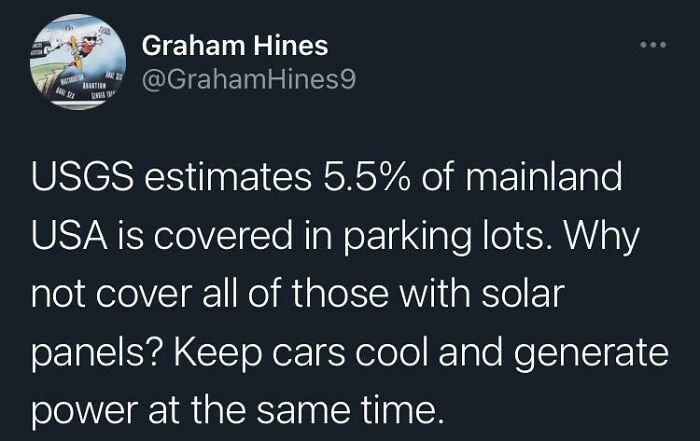
Image credits: lostintheriver23
#33 Can Someone Check The Conversion Rate And Inflation On This One? Merry Christmas!
"According to the Wikipedia arcticle for bob cratchit 15 shilling per week back then amounts to £36 or $54 US per week in 2015. With 52 weeks in a year (actual 1843 week count), that amoungs to $54*52=$2,808. The statement in the Post is incorrect."
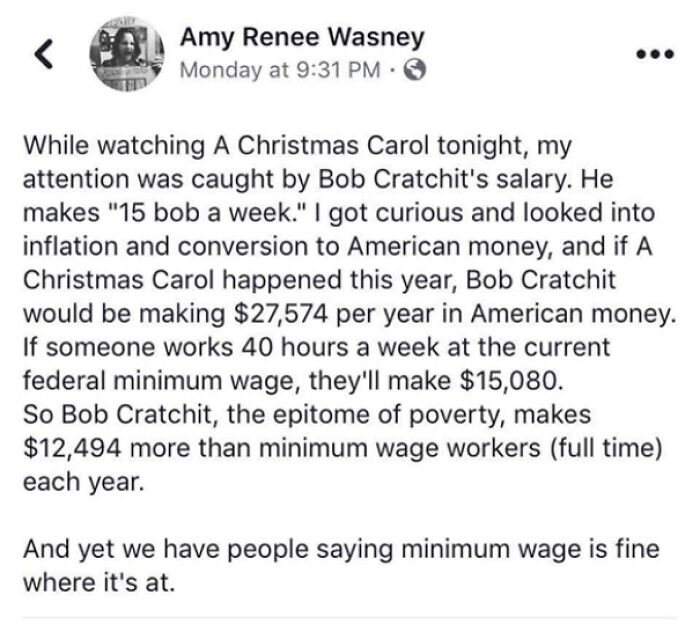
Image credits: kdods22402
#34 How Much Would The Eurotunnel Have Cost If It Were Built On The Seabed And Had A Glass Roof Like This Post?
"Well,
The euro tunnels under water sections is around 37km. That’s around $560,000/m. The glass needed is about $10,000/m without instalment costs. Labour in France is about $0.50 less than the UK for this job but I’ll just average out at about $20 per hour at about 20 metres per day or five years for the whole tunnel.
If there were 1000 workers it would be about $20,000/hour. At 8 hours a day, 350 days a year for 5 years is 14,000 hours or $280,000,000 in labour costs.
If you add the cost for parts from before it makes around $21billion. I’ll assume it’s higher at around $30billion though. If you adjust for inflation it makes around $47billion."

Image credits: techie410
#35 Just Saw This Meme And It Seems Wildly Out Of Proportion. Can Someone Confirm Or Give Me A More Accurate Number To Share With My Buddies?
"Golf courses are between 5000-7000+m long on average on the card plus extra walking and the fact that unless you are pro you arent going in a straight line the whole time you can do nearly the same again.
Assuming 6 mile (9.6km) walked per round, 1 round per week minus 2 for holidays that would give 50*6 or 300 miles.
Assuming one has a pint at the end of each round, that would give 50 pints or 6.25 gallons
My math says that that equals 48mpg
So the numbers look like they are assuming 3 rounds a week but the ratio is there or there abouts"
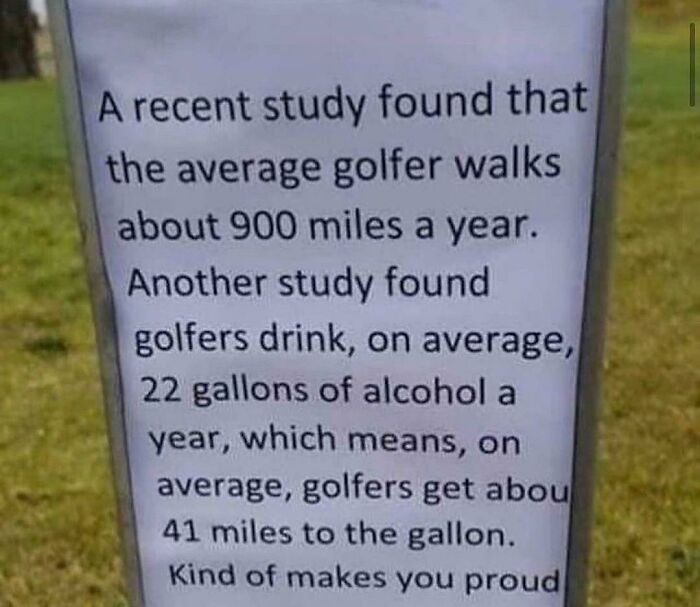
Image credits: Benign_Banjo
#36 How Many Km Of Rna Is Needed To Vaccinate The Entire World?
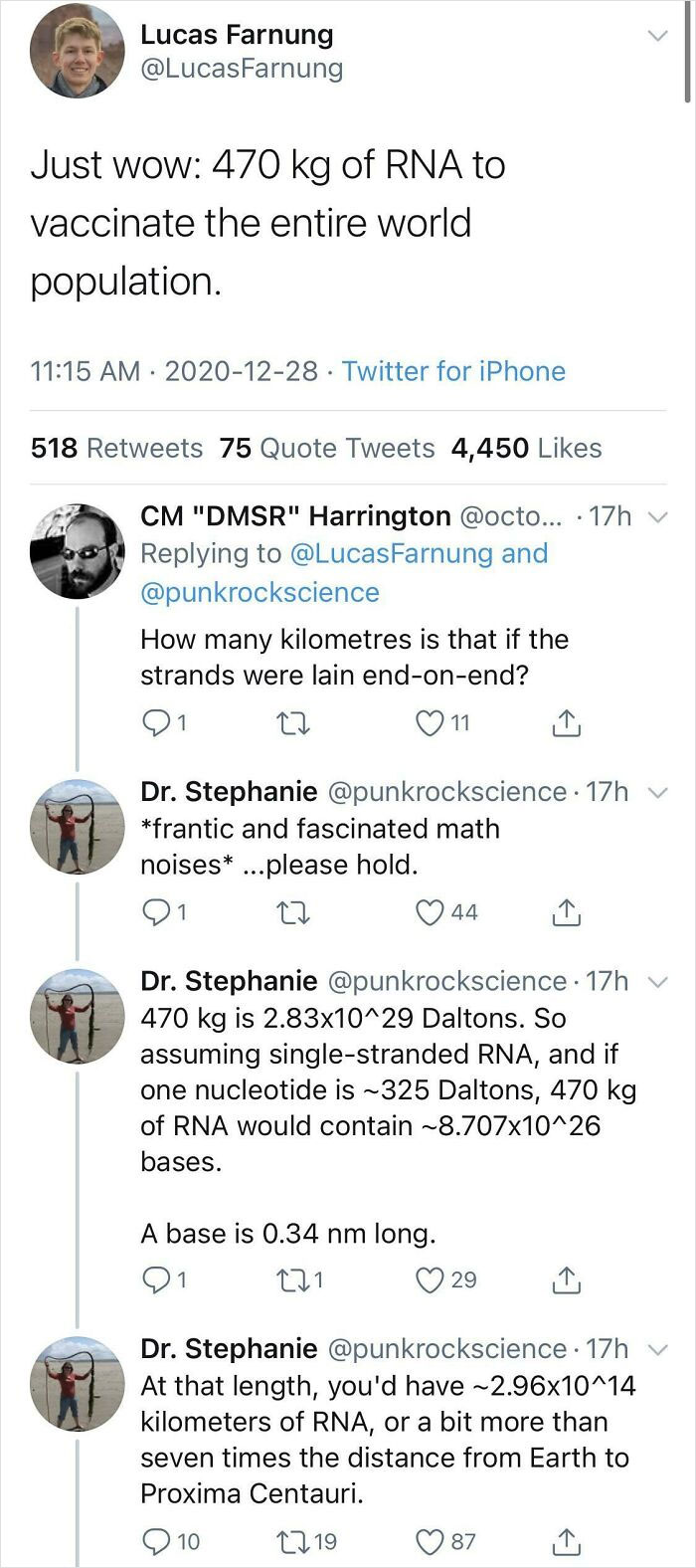
Image credits: pennyunw1se
#37 How Many People Would Be Autistic Today If That Number Was Correct?
"In the early 1980s, >95% of children were fully vaccinated prior to school entry. In 2019-2020, this had dropped to roughly 95% of children entering school being vaccinated.
Suppose we are idiots and ignore the following:
Autism as a diagnosis has undergone major changes over the decades,
People with autism were essentially rendered invisible prior to the 1980s because they were institutionalized
People are screened for autism now, instead of diagnoses happening only if a physician was familiar with the concept
Then we'd look at the change in autism rates from <1/1400 (above cite) in the 1980s to 1/54 today, and conclude that the drop in vaccination rates has occurred during a 2500%, not 30,000% increase in autism.
This is from 40 years ago, not 50, but the data before 1980 was so sparse and badly reported that there really is no point to trying to use it."

Image credits: kadebo42
#38 Hey Google, How Many Days Since July 4th, 1776?
"89,539 days"
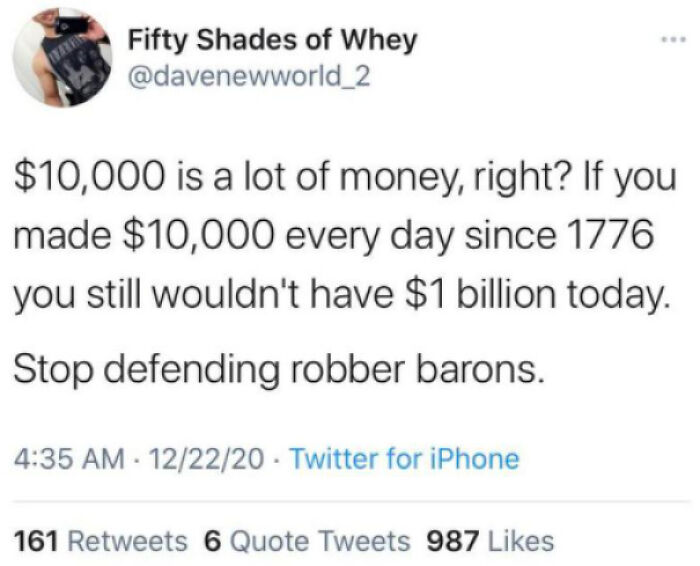
Image credits: The5am1am
#39 In 100 M Of Space, How Many More Bricks Would A Regular Straight Fence Have?
"As you can see in the picture it's a very thin wall, looks to be 1 brick thick. A straight wall only has support on one axis and would need to be at least a few bricks thick to stay standing. The curved wall allows more support in multiple axis allowing the use of less bricks."

Image credits: IceZ__
#40 How Much Would A Whole Pizza Be Worth?
"Ok so we know that a pizza is round, and we have the radius of the pizza as well a a part of an arc.
To measure the radius, I straighted the pizza and found out that it was about 778 pixels long. With that, I calculated that the circumference of the pizza was 4488.32. The crust's length is 137.17, which is is 3.05% of the pizza.
If 3.05% of the pizza is worth 600$, then the whole pizza is 19672.13$."

Image credits: FNILife
#41 How Dense Would This Person Be? What Materials/Elements Would They Be Comparable To?
"So BMI is calculated as weight divided by the square of your height, e.g. 80kg / 1.8m2 = 24.69
In this case, we change the formula to yield the BMI:
28000 * (0.0622) = his weight being 107.63 kg.
Assuming he is a perfect cube with 6.2cm side length, that puts his volume at 6.23 cm = 238.33cm3.
Density is m/V, thus 450g/cm3
Osmium as the densest element at standard conditions is only 22.57g/cm3, putting him at about 20x that. If we go by a humanoid shape, it'd be even higher as he doesn't fill all the room in the "cube"."
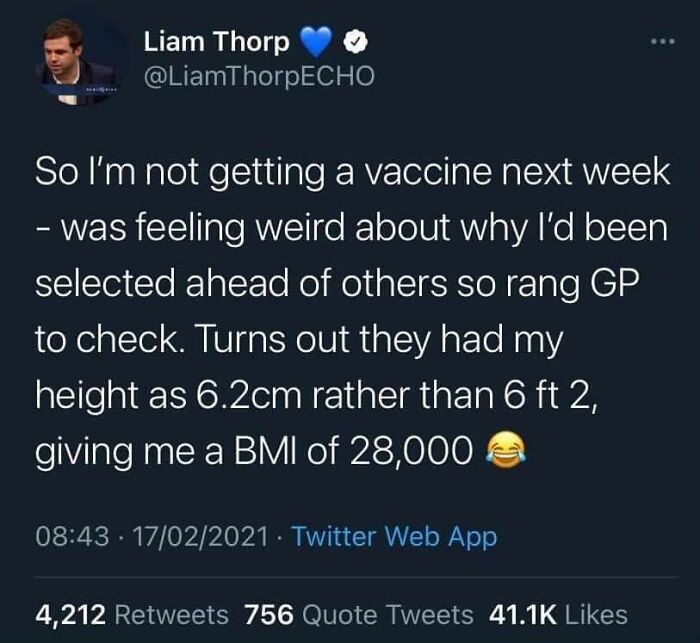
Image credits: troutbeard
#42 Calculates The Ferrari 250 Gto Is Worth More Than Its Weight In Gold

Image credits: reddit.com
#43 That‘S A Lot Of Spiders...
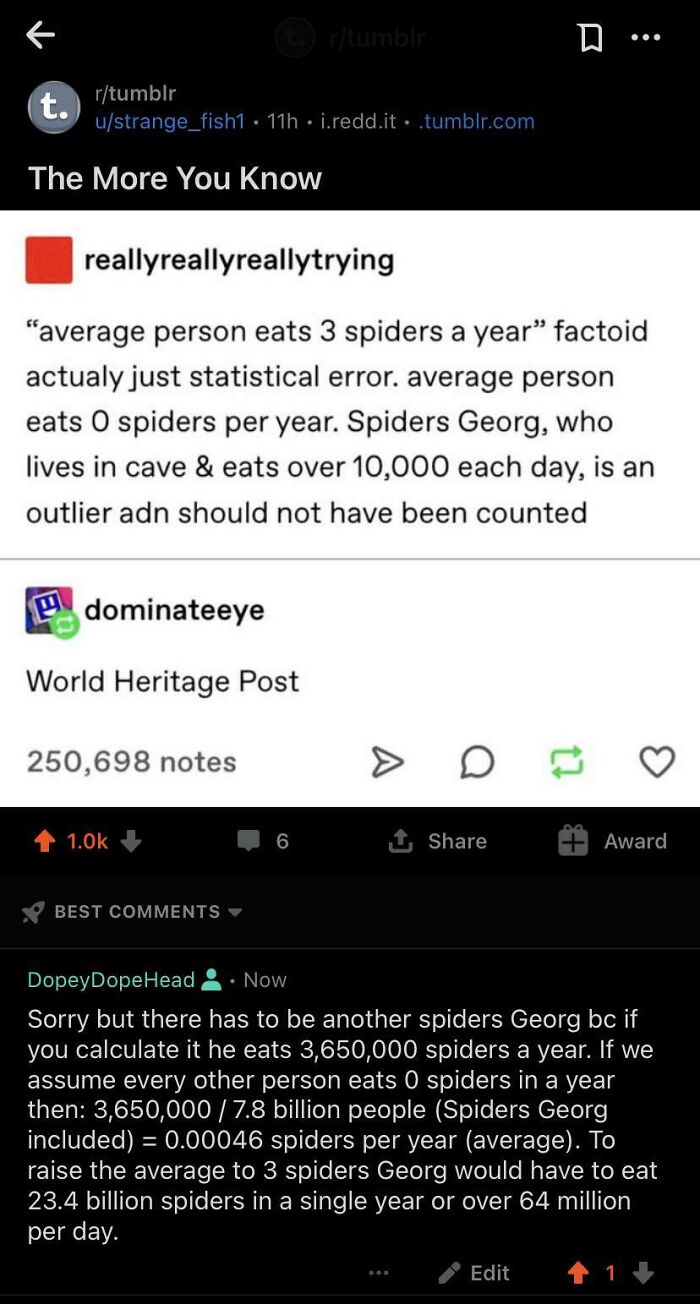
Image credits: DopeyDopeHead
#44 How Many Of These Crabs Would It Actually Take To (Very Slowly) Run Doom?
"The lowest doom port that i would consider borderline playable is the port for the ti-83 plus.
The ti-83 plus features the zilog z80 as its main processor.
The zilog z80 has 8500 transistors.
You need a minimum of 2 transistors for the most basic logic gates.
So if you need 80 crabs per gate and we have 8500/2 gates, you require at least 340000 crabs to play a version of doom, albeit a very basic one."
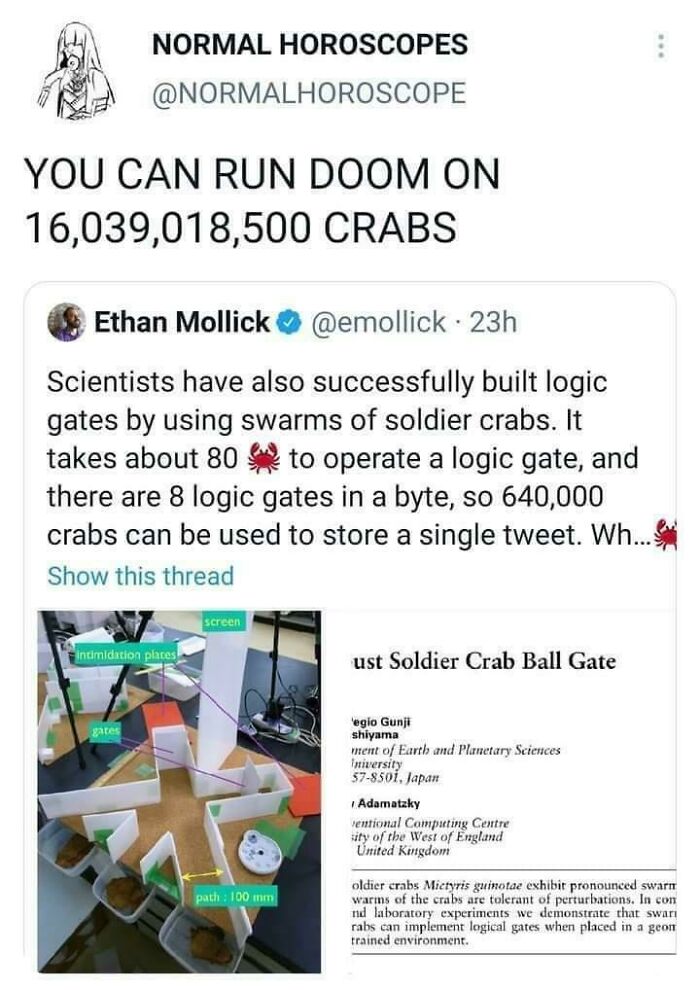
Image credits: hairy_eyeball
#45 Is That True?
"Right off the bat, I can say that the sucker would have to be pure U-235, which would mean 141.85 times that amount of U-238 would also be produced, which would need to be extracted from ore and enriched and a whole bunch of other processes. And that U-238 is slightly radioactive too, so while you might only have a Dum Dum’s worth of fission biproducts, you’d have a lot of slightly radioactive U-238, as well as the ore waste.
Mathwise, we got: Energy yield, approximated: 82 TJ/kg Uranium-235 (https://bit.ly/38S2wlU)
Density of Uranium: 19 g / cm3 (https://bit.ly/3tsOikZ)
Percent of U-235 in Uranium metal: .7% (Same as two above)
Volume of a Dum Dum: ~.06545 in ^ 3 or 1.072 cm3
Mass of Uranium of Dum Dum size: 20.37 grams
Mass of U-235 in sample: .142 grams
Energy released by .142 grams U-235: 11.70 GJ
Avg American’s energy consumption yearly: 10,909 kWh = 39,272,400,000 joules (about 39 Gigajoules)
Conclusion: the Uranium Dum Dum would only supply the average American with a little under four year’s worth of power, assuming my numbers are correct (it’s 3:57 in the morning and I don’t know why I’m even doing this to myself so links be damned). If the Uranium Dum Dum was, however, fully U-235, we’d no longer have a mere Uranium Dum Dum, but a Nuclear Dum Dum. And that Nuclear Dum Dum would give off approximately 1.67 Terrajoules of energy, which when divided by 39 GJ per year you get 42.82 (I feel like I may have missed a 2 here but again, 4:02 in the morning).
So, the first part might be correct if (I missed a two or my numbers are wrong) AND (the Dum Dum is 100% U-235). The second part is flat out wrong because it ignores the rest of the waste of the process to get that Uranium. The third part, I can’t be asked because 4:06, but seems like with those numbers it’s probably legit. I’ll leave that to somebody else instead.
Use Thorium instead. It’s cleaner and plays nicer. But I’m not running the numbers for again. These numbers might be wrong so please check peoples. : ) I’m going to bed for now."
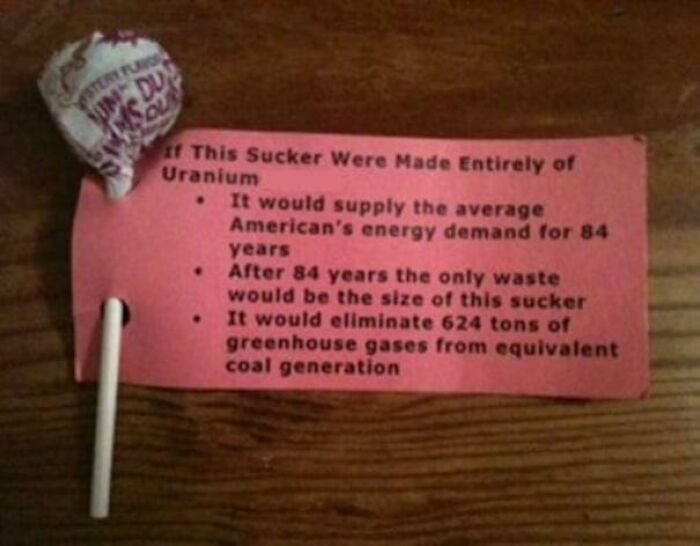
Image credits: surrys52
#46 Is This Accurate With How Much Their Tax Is? Or Is This Hooey?
"That just looks like a 3% tax. If that's what you're talking about, then it's accurate.
To do the math, take the "leave them with" amount, add back in the "would owe" amount, and you have the amount they're starting with. Multiply that by .03 and you get the "would owe" amount again."
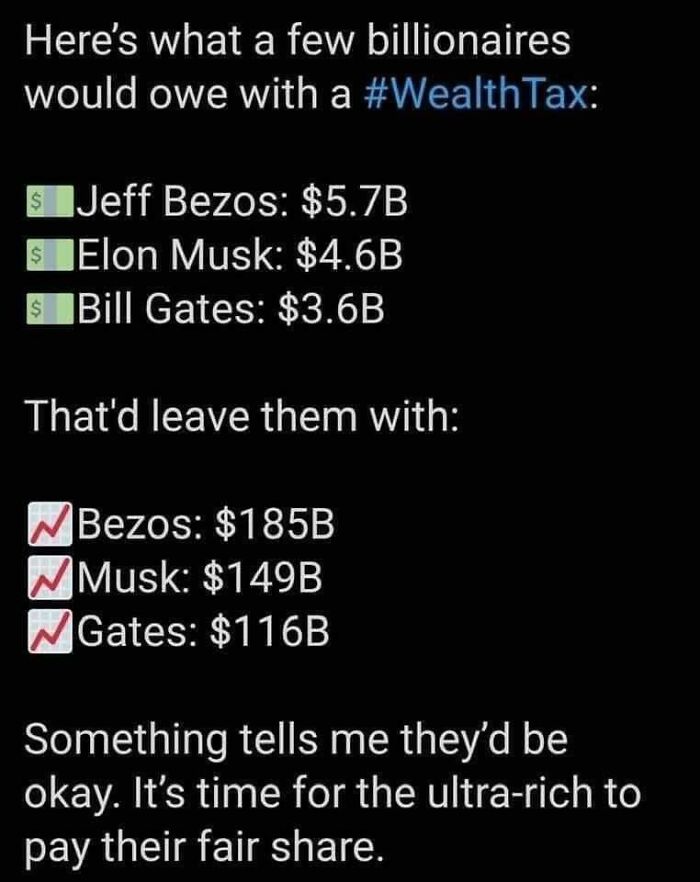
Image credits: bullsaint
#47 So How Many Bees Per Sq. In To Get To 20k?
"Beekeeper here. No one counted them. 20,000-30,000 bees is the typical colony size of a healthy hive. Sometimes, particularly in late spring, Bees will decide to abandon the hive and 'swarm' to a new location. Which is sometimes a car, but is usually a tree branch"

Image credits: frostiandfuzzi
#48 How Long Before Humanity Is Wiped Out? And How Much Money Will Have Been Made At The End?
"Assuming 10 clicks per second and 7.88 billion people on earth. That would take 25 years.
At $10,000 per kill that would be $78,800,000,000,000.
That’s $78.8 trillion.
Of course if you could get an auto clicker to go at 100 times per second it would be 2.5 years. Or at 1,000 clicks per second it would take about 3 months. The amount of money wouldn’t really change as the number of clicks remains the same, just the time in which all clicks are completed is shorter.
This of course doesn’t take account of population growth. The world population is growing by approximately 2.7 people per second (births - deaths). So if the clicker was only 10 per second it would actually take longer than 25 years as at the start of clicking the net reduction would only be about 7.3 people per second. As the Population declines the number of new births will also decline, so the rate of net population decline would speed up. But that maths is too difficult for me to work out. At 100 or 1000 clicks per second the effect of births will be negligible so 2.5 years or 3 months is probably relatively accurate."

Image credits: CmdrCloud
#49 I Don't Believe Facebook Memes, So I Came To You!
"I think it’s a bit unbalanced to only be accounting for O2 . Some people produce more CO2 than others. To look at O2 only, is just offsetting O2 consumption. We want trees that would be good carbon sinks right? To balance the CO2 would be better. I’ll do some math during lunch. A while ago the US dropped some very large ordinance in Afghanistan and an article was published detailing how the weapon produced less CO2 than the people would have. We can improve this meme"
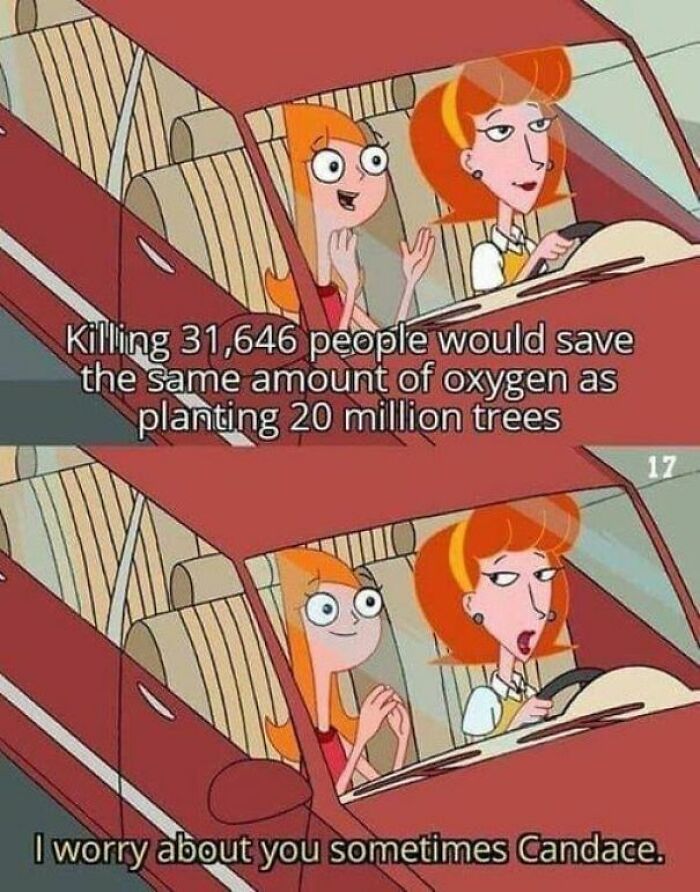
Image credits: lame_spider
#50 One Comment Said "This Is Equivalent To 22 Lattes Per Day Since Birth" Is That Accurate? Please Do The Math
"That would imply he's lived over a billion days. Not even remotely close.
Elon Musk was born on June 28, 1971, that's 18,109 days ago.
34.67 billion lattes over 18,109 days are
34,670,000,000 / 18,109 =~ 1,914,518 lattes per day.
That's 34,670,000,000 / 18,109 / 24 / 60 / 60 =~ 22.16 lattes per second."
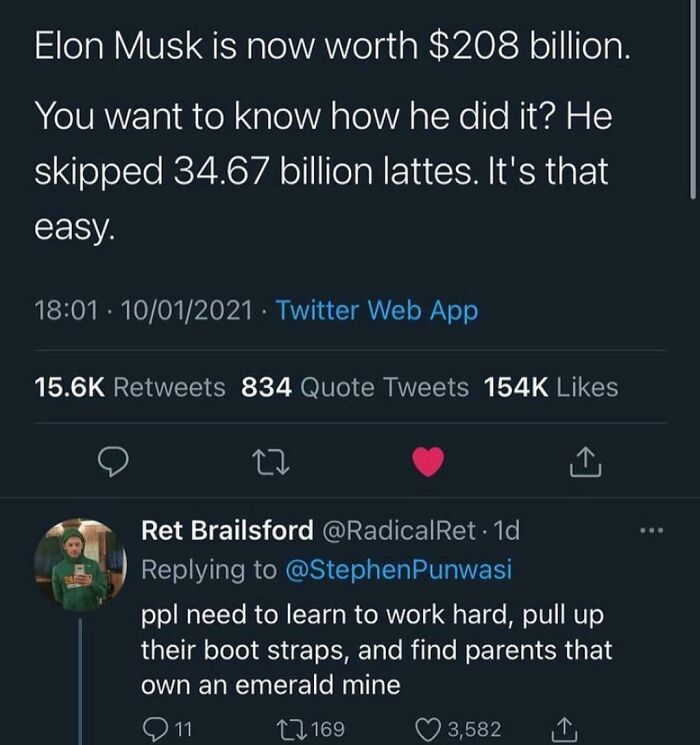
Image credits: utkxrsh7
#51 Can You Help Me Calculate This?
"(365x364x363x...x344)/(36523 ) = 0.51568 Which is about 50/50. This is the probability of unique birthdays, then you can just subtract from 1 to get your answer.
The probability the first person has a unique birthday is 1, the probability that a second person has a birthday that is different to the first person is 364/365, next person 363/365, and so on. Taking the product of these probabilities, and subtracting it from one will yield the result."
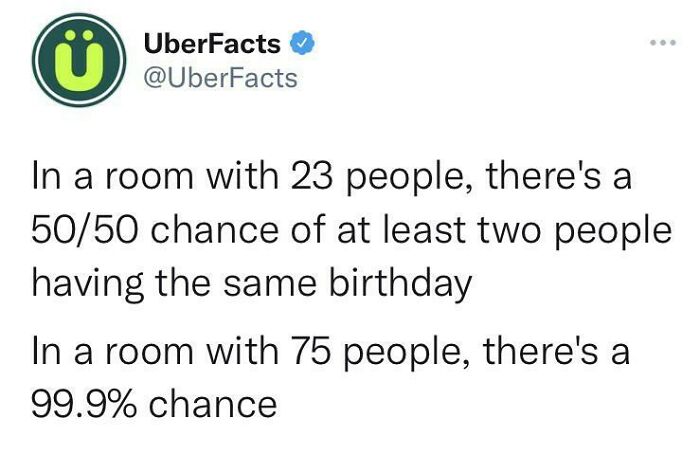
Image credits: lethalintelligence
#52 Is This True? And If It Is True, Without Considering Side Expenses, What Will Be The Cost Of Actually Building It? Found This And Tough It Was Interesting But Couldn't Find Verification. It Is A Problem Requiring A Lot Of Information ( I Think) And I Am Not Sure How To Tackle It
"i mean 1.2% of 3,552,000 is roughly 43,000 square miles.
jesus christ imagine how big that solar farm would be.
it is equivalent to literally covering an area the size of the entire state of Virginia..."
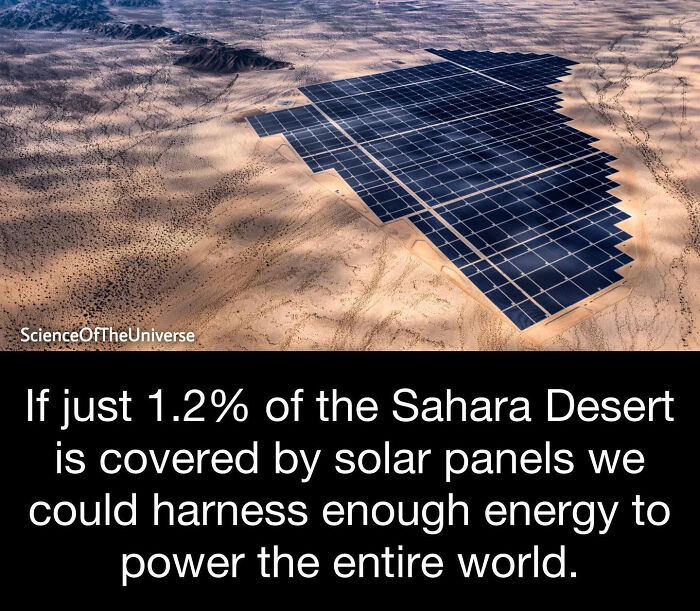
Image credits: svkanev
#53 How Many Shares Would Actually Be Required To Make This Much Money?
"Mayweather claims there's $1.8m on the table.
Buying at $1.04 and selling at $1.06 is a profit of $0.02 a share.
$1800000 / $0.02/share = 90 million shares.
Ignoring fees and taxes, of course."

Image credits: jacksoncranford
#54 What Are The Percentages Of People Dying To Covid Compared To People Dying Of The Vaccine?
"Looking at the official numbers there have been about 600k deaths out of 33.6 million COVID-19 cases. About 178 million people have gotten the COVID-19 vaccine. Fot the risk to be the same there would have to be about 3 million deaths from the vaccine and even the most extreme people are saying 5k, which is a severe over count."
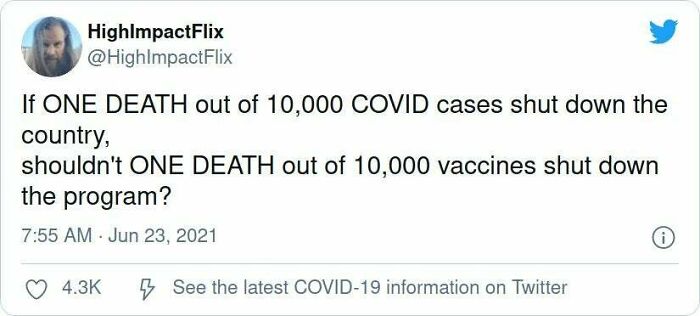
Image credits: Neefew
#55 What Are The Odds Of This Happening?
"Assuming the question is really what are the odds of buying 2 successful tickets in a row.
That's going to be determined by the odds of those two prizes.
Let's assume a 1 in 60,000 chance for the car and a 1 in 600,000 chance for the jackpot. Which seems reasonable enough based off these odds. I've assumed a $10 ticket for the jackpot (which matches the top prize) and because it was a re-enactment I'm going to assume the first ticket that won a car was also $10 meaning it was not top prize, hence the better odds (assumed roughly proportionate to the prize value).
The probability is then 1/60000 x 1/600000 = 1/(6x104 x 6x105) = 1/(3.6 x 1010) or 1 in 36 billion."

Image credits: Liz45d
from Bored Panda https://bit.ly/3jYuS42
via Boredpanda